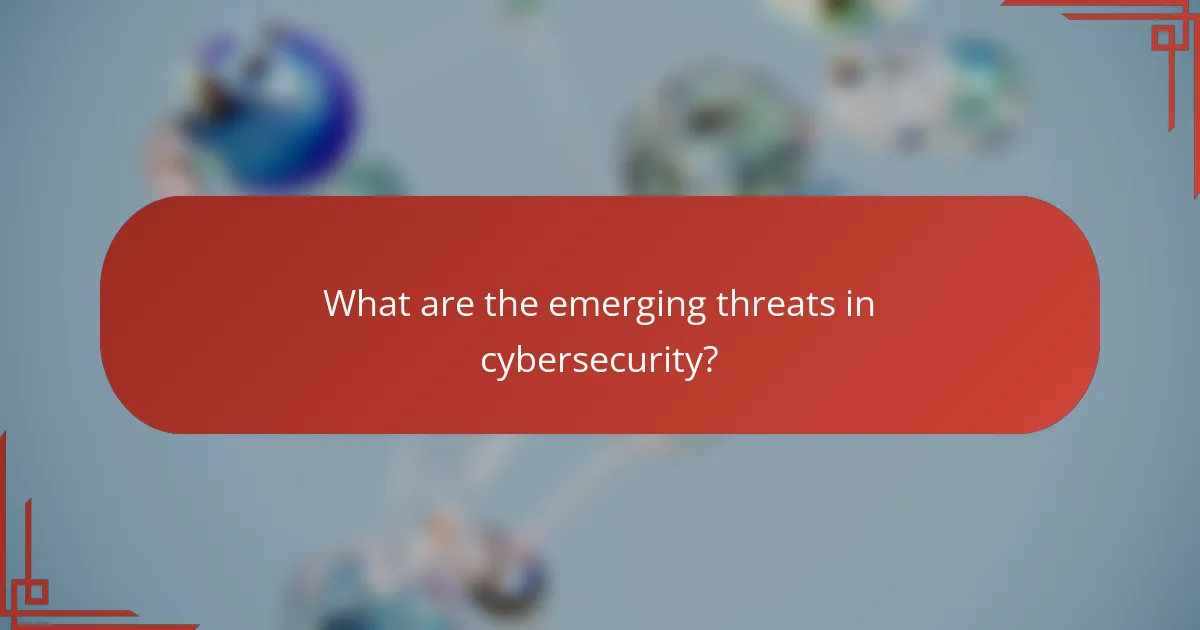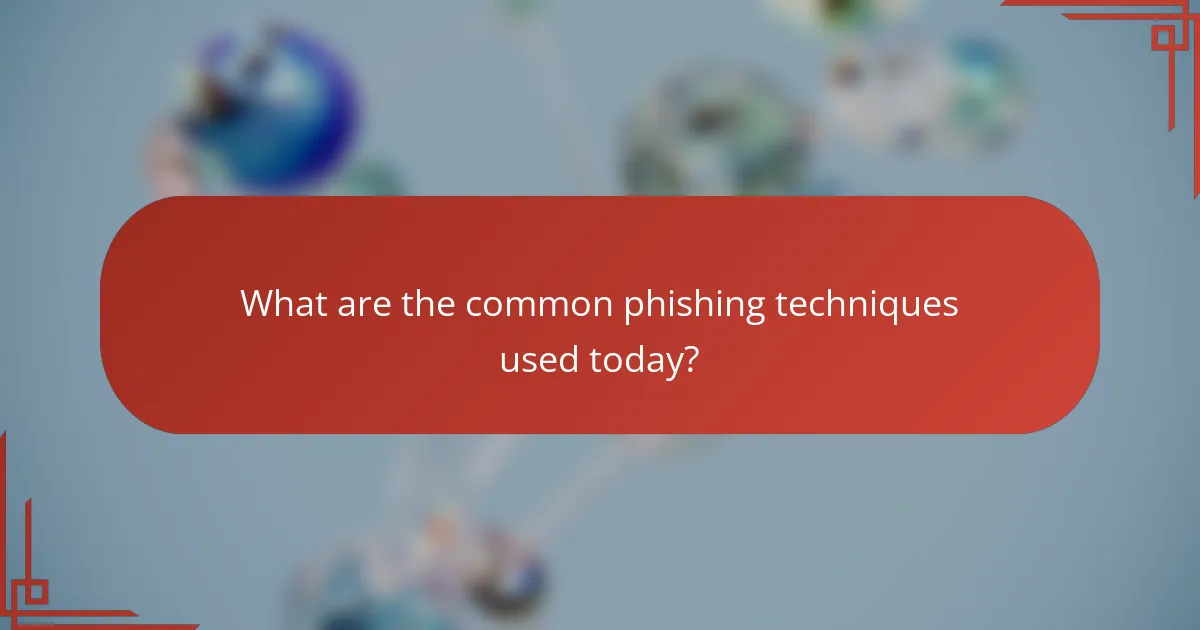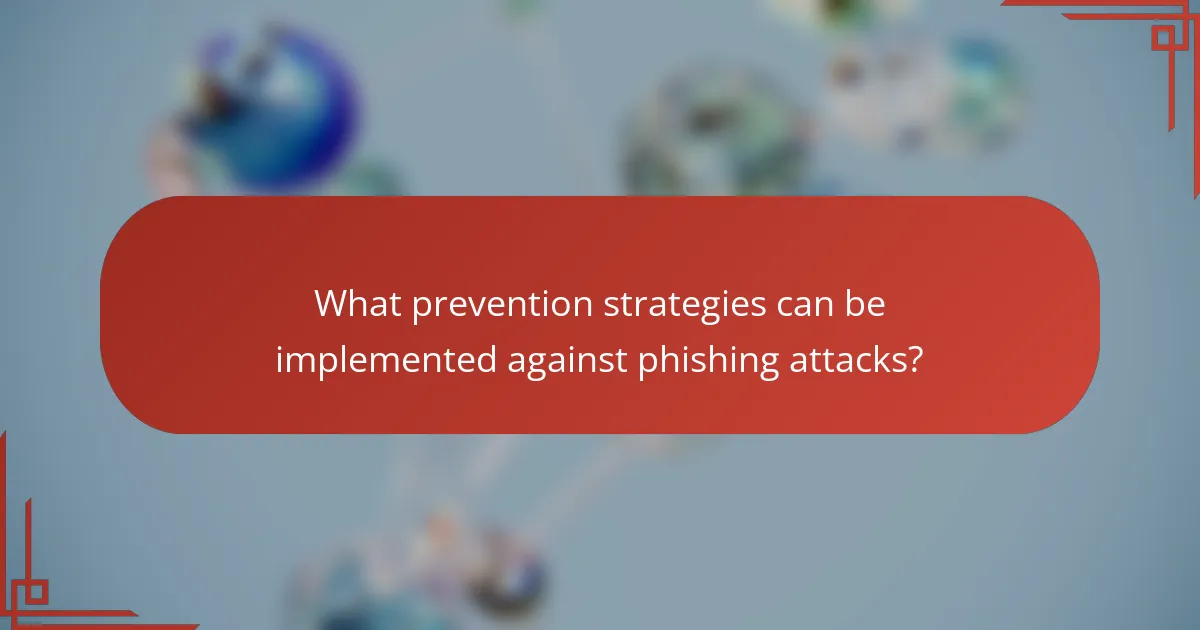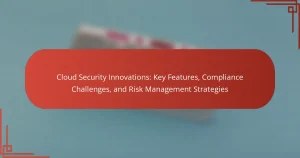Emerging threats in cybersecurity, particularly advanced phishing attacks, ransomware, and artificial intelligence-driven exploits, pose significant risks to individuals and organizations. Advanced phishing techniques, such as email phishing, spear phishing, whaling, vishing, smishing, and business email compromise (BEC), exploit social engineering to deceive victims and gain unauthorized access to sensitive information. The rise in ransomware incidents targeting critical infrastructure highlights the urgency of addressing these threats, with cybercrime projected to cost the global economy $10.5 trillion annually by 2025. Effective prevention strategies, including employee training, multi-factor authentication, email filtering, and regular software updates, are essential for mitigating the risks associated with these emerging cybersecurity threats.

What are the emerging threats in cybersecurity?
Emerging threats in cybersecurity include advanced phishing attacks, ransomware, and artificial intelligence-driven exploits. Advanced phishing attacks have become more sophisticated, using social engineering to deceive users. Ransomware incidents have increased, targeting critical infrastructure and demanding hefty payments. Artificial intelligence is being leveraged by cybercriminals to automate attacks and identify vulnerabilities. According to a report by Cybersecurity Ventures, cybercrime is projected to cost the world $10.5 trillion annually by 2025. This statistic underscores the urgency of addressing these emerging threats.
How do phishing techniques fit into the landscape of cybersecurity threats?
Phishing techniques are a significant subset of cybersecurity threats. They exploit human psychology to deceive individuals into revealing sensitive information. Cybercriminals use various methods such as emails, fake websites, and social media messages. According to the Anti-Phishing Working Group, phishing attacks have increased by 220% from 2019 to 2020. This rise indicates that phishing remains a prevalent threat in the cybersecurity landscape. Phishing attacks often serve as entry points for more severe breaches, including identity theft and financial fraud. Organizations must recognize phishing as a critical threat and implement robust training and prevention strategies.
What are the different types of phishing attacks?
Phishing attacks can be categorized into several types. The most common types include email phishing, spear phishing, whaling, vishing, and smishing.
Email phishing involves sending fraudulent emails to trick users into revealing sensitive information. Spear phishing targets specific individuals or organizations, often using personal information to increase credibility. Whaling is a form of spear phishing that specifically targets high-profile individuals, such as executives. Vishing utilizes voice calls to deceive victims into providing personal data. Smishing involves sending fraudulent SMS messages to lure victims into revealing information or clicking malicious links.
These classifications help in understanding the various tactics employed by cybercriminals to exploit vulnerabilities.
How have phishing techniques evolved over time?
Phishing techniques have evolved significantly over time, adapting to technological advancements and user behaviors. Initially, phishing involved simple email scams that mimicked legitimate organizations. These early attempts often included poorly crafted messages with obvious spelling errors. As internet security improved, attackers became more sophisticated. They began using social engineering tactics to create urgency and manipulate emotions.
In the mid-2000s, spear phishing emerged. This targeted approach used personalized information to deceive specific individuals. Attackers researched their victims to craft convincing messages. By the 2010s, phishing techniques included the use of fake websites that closely resembled legitimate ones. These sites often tricked users into entering sensitive information.
Today, phishing has further evolved with the rise of mobile devices. Attackers now exploit SMS and messaging apps for phishing attempts. They also use advanced techniques like domain spoofing and URL shortening to hide malicious links. According to the Anti-Phishing Working Group, there were over 200,000 phishing attacks reported in the first quarter of 2021 alone. This demonstrates the ongoing evolution and prevalence of phishing threats.
Why is understanding phishing techniques important for cybersecurity?
Understanding phishing techniques is crucial for enhancing cybersecurity. Phishing attacks exploit human vulnerabilities to gain unauthorized access to sensitive information. Recognizing these techniques allows individuals and organizations to implement effective prevention strategies. For instance, the Anti-Phishing Working Group reported over 200,000 phishing attacks monthly in 2021. This statistic highlights the prevalence and risk associated with such attacks. Being informed about phishing methods helps in identifying suspicious communications and mitigating potential threats. Ultimately, understanding phishing is essential for safeguarding data and maintaining cybersecurity integrity.
What impact do phishing attacks have on individuals and organizations?
Phishing attacks significantly impact both individuals and organizations by compromising sensitive information and financial assets. Individuals may suffer identity theft, leading to financial loss and emotional distress. According to the Federal Trade Commission, consumers reported losing over $1.9 billion to fraud in 2020, much of which was attributed to phishing schemes. Organizations face substantial risks, including data breaches, loss of customer trust, and financial penalties. A report by Verizon indicated that 22% of data breaches involved phishing, highlighting the vulnerability of businesses. Additionally, the recovery process from a phishing attack can be costly and time-consuming, often requiring extensive security measures and legal consultations. Overall, the ramifications of phishing attacks are profound, affecting personal security and organizational integrity.
How do phishing attacks compromise sensitive information?
Phishing attacks compromise sensitive information by deceiving individuals into providing personal data. Attackers often use fraudulent emails or websites that appear legitimate. These communications typically contain urgent requests for information. When users respond, they inadvertently share passwords, credit card numbers, or social security numbers. According to the Anti-Phishing Working Group, there were over 200,000 reported phishing attacks in a single month in 2020. This widespread tactic exploits human psychology, leveraging fear or curiosity. Once attackers gain access to sensitive data, they can commit identity theft or financial fraud.

What are the common phishing techniques used today?
Common phishing techniques used today include email phishing, spear phishing, and whaling. Email phishing involves sending bulk emails that appear to be from legitimate sources. The goal is to trick recipients into revealing personal information. Spear phishing targets specific individuals or organizations, using personalized information to increase credibility. Whaling is a type of spear phishing aimed at high-profile targets, such as executives.
Another technique is vishing, which uses voice calls to deceive victims. Smishing involves phishing through SMS messages, often leading to malicious links. Clone phishing duplicates a legitimate email that the victim has previously received, altering it to include a malicious link. Finally, business email compromise (BEC) scams impersonate executives to authorize fraudulent transactions.
According to the 2021 Verizon Data Breach Investigations Report, phishing remains a leading cause of data breaches, emphasizing the need for awareness and prevention strategies.
How do spear phishing and whaling differ from traditional phishing?
Spear phishing and whaling are targeted forms of phishing, differing from traditional phishing in their specificity and approach. Traditional phishing casts a wide net, targeting numerous individuals with generic messages. In contrast, spear phishing focuses on specific individuals or organizations, using personalized information to increase the likelihood of success. Whaling is a subtype of spear phishing that specifically targets high-profile individuals, such as executives or important decision-makers. According to the Anti-Phishing Working Group, spear phishing attacks are more effective due to their tailored nature, leading to higher rates of successful breaches. This targeted approach often results in significant financial and data losses for organizations.
What are the characteristics of spear phishing attacks?
Spear phishing attacks are targeted attempts to steal sensitive information from specific individuals or organizations. These attacks often use personalized information to increase the likelihood of success. Attackers research their targets to craft convincing messages. Common characteristics include the use of familiar names or organizations in the communication. They often create a sense of urgency to prompt immediate action. Spear phishing emails may contain malicious links or attachments. According to the 2021 Verizon Data Breach Investigations Report, 36% of breaches involved phishing. This statistic highlights the prevalence and danger of spear phishing tactics.
Why are high-profile individuals targeted in whaling attacks?
High-profile individuals are targeted in whaling attacks due to their access to sensitive information and resources. Attackers exploit their positions to gain financial or strategic advantages. These individuals often have significant influence, making them attractive targets for cybercriminals. Whaling attacks are typically more personalized and sophisticated than regular phishing attempts. Attackers research their targets extensively to craft convincing messages. This increases the likelihood of successful deception. According to the Anti-Phishing Working Group, whaling attacks have increased by 400% in recent years. This statistic highlights the growing threat to high-profile individuals in cybersecurity.
What role does social engineering play in phishing attacks?
Social engineering is a critical component of phishing attacks. It involves manipulating individuals into divulging confidential information. Attackers exploit psychological tactics to create a sense of urgency or fear. For example, they may pose as trusted entities like banks or government agencies. This deception encourages victims to click on malicious links or provide sensitive data. Research indicates that 97% of people cannot identify a phishing email. This statistic highlights the effectiveness of social engineering in these attacks. Consequently, understanding these tactics is essential for prevention and awareness.
How do attackers manipulate emotions to execute successful phishing?
Attackers manipulate emotions to execute successful phishing by leveraging fear, urgency, and curiosity. They create messages that provoke anxiety, prompting individuals to act quickly without critical thinking. For example, phishing emails often warn of account suspensions, compelling users to click on malicious links to resolve issues. This tactic exploits the fear of losing access to important services.
Additionally, attackers may invoke a sense of urgency by claiming limited-time offers or immediate action required. This pressure can cloud judgment, leading to hasty decisions. Curiosity is also a powerful tool; attackers may use intriguing subject lines to entice recipients to open emails.
Research indicates that emotional responses significantly affect decision-making processes, often leading to compromised security. A study by the University of Southern California found that emotional appeals in phishing attempts increase the likelihood of user engagement. By understanding these emotional triggers, attackers can design more effective phishing schemes.
What psychological tactics are commonly used in phishing schemes?
Phishing schemes commonly use psychological tactics such as urgency, fear, and social proof. Urgency creates a sense of immediate action, compelling targets to respond quickly. Fear tactics exploit anxiety about account security or financial loss. Social proof involves leveraging authority or peer behaviors to persuade individuals to comply. For example, a phishing email may claim that “many users are verifying their accounts” to encourage action. These tactics manipulate emotions, making victims more likely to fall for scams. Research shows that 90% of successful cyberattacks involve human error, highlighting the effectiveness of these psychological strategies.

What prevention strategies can be implemented against phishing attacks?
Implementing prevention strategies against phishing attacks is essential for cybersecurity. Regular employee training on recognizing phishing attempts can significantly reduce risks. Using multi-factor authentication adds an extra layer of security. Email filtering solutions can help detect and block phishing emails before they reach users. Keeping software and systems updated minimizes vulnerabilities that attackers exploit. Regularly backing up data ensures recovery in case of a successful attack. Utilizing domain-based message authentication, reporting, and conformance (DMARC) helps validate email sources. These strategies collectively strengthen defenses against phishing threats.
How can organizations educate employees about phishing risks?
Organizations can educate employees about phishing risks through comprehensive training programs. These programs should include interactive sessions that illustrate real-life phishing scenarios. Regularly scheduled workshops can reinforce learning and keep employees updated on new phishing techniques. Organizations can also utilize simulated phishing attacks to test employee awareness and response. Providing clear guidelines on identifying suspicious emails is essential. Additionally, distributing informative materials like newsletters can keep phishing risks top of mind. Statistics show that organizations with regular training see a significant reduction in successful phishing attempts. For instance, a report by the Anti-Phishing Working Group indicated that organizations with ongoing training programs reduced phishing susceptibility by over 50%.
What training programs are effective in raising phishing awareness?
Effective training programs for raising phishing awareness include interactive simulations and comprehensive workshops. These programs engage participants through real-life scenarios. They help users identify phishing attempts in a safe environment. Research shows that users who undergo simulation training are 70% less likely to fall for phishing attacks. Workshops often include discussions on the latest phishing tactics. They also provide resources for recognizing suspicious emails. Regular updates to training content ensure relevance against evolving threats. Programs like KnowBe4 and PhishMe are widely recognized for their effectiveness.
How can simulated phishing attacks help in training?
Simulated phishing attacks enhance training by providing realistic scenarios for users to practice identifying threats. These simulations mimic actual phishing attempts, allowing employees to experience potential attacks in a controlled environment. Participants learn to recognize common tactics used by attackers, such as deceptive emails and misleading links. This hands-on experience improves their ability to respond effectively to real threats. Research indicates that organizations utilizing simulated phishing training see a significant reduction in successful phishing incidents. For example, a study by the Ponemon Institute found that companies implementing such training reduced click rates on phishing emails by up to 70%.
What technical measures can be taken to prevent phishing?
Implementing technical measures to prevent phishing involves several key strategies. One effective measure is deploying email filtering solutions. These solutions analyze incoming emails for phishing indicators and block suspicious messages. Another measure is using multi-factor authentication (MFA). MFA adds an extra layer of security, making unauthorized access more difficult.
Regularly updating software and systems is also crucial. Security patches help close vulnerabilities that attackers may exploit. Organizations can use anti-phishing toolbars in web browsers. These toolbars alert users to known phishing sites. Training employees on recognizing phishing attempts is essential as well. Educated users are less likely to fall victim to phishing attacks.
Another technical measure is implementing Domain-based Message Authentication, Reporting & Conformance (DMARC). DMARC helps prevent email spoofing by ensuring that only authorized senders can use a domain. Additionally, using Secure Sockets Layer (SSL) certificates can enhance security. SSL encrypts data transmitted between users and websites, making it harder for attackers to intercept information.
Collectively, these technical measures create a robust defense against phishing threats.
How do email filters and security software help in reducing phishing threats?
Email filters and security software significantly reduce phishing threats by identifying and blocking malicious emails. These tools analyze incoming messages for suspicious characteristics. They use algorithms to detect known phishing patterns and keywords. Filters can also check the authenticity of sender addresses. Security software often includes real-time threat intelligence updates. This means they adapt to new phishing techniques quickly. According to the Anti-Phishing Working Group, effective filters can reduce phishing email delivery rates by over 90%. By preventing access to harmful links, these tools protect users from potential data breaches.
What role does multi-factor authentication play in phishing prevention?
Multi-factor authentication (MFA) significantly enhances phishing prevention by adding layers of security. MFA requires users to provide two or more verification factors to gain access. This process makes it harder for attackers to compromise accounts, even if they obtain passwords through phishing. For example, if a user’s password is stolen, the attacker still needs the second factor, such as a text message code or authentication app. According to a report by Microsoft, MFA can block over 99.9% of account compromise attacks. This statistic underscores the effectiveness of MFA in protecting against phishing threats. Therefore, implementing MFA is a critical strategy in reducing the risk of successful phishing attacks.
What best practices should individuals follow to avoid phishing scams?
Individuals should follow specific best practices to avoid phishing scams. First, they should verify the sender’s email address before clicking on any links. Phishing emails often use addresses that look similar to legitimate ones. Second, individuals must avoid clicking on links or downloading attachments from unknown sources. These actions can lead to malware installation. Third, they should use two-factor authentication whenever possible. This adds an extra layer of security to accounts. Fourth, individuals must keep their software and security systems updated. Regular updates help protect against vulnerabilities. Fifth, they should educate themselves about common phishing tactics. Awareness of these tactics reduces the likelihood of falling victim. Lastly, individuals should report phishing attempts to their email provider. Reporting helps improve detection systems and protects others.
How can users identify suspicious emails and links?
Users can identify suspicious emails and links by examining several key indicators. First, check the sender’s email address for inconsistencies. Phishing emails often use addresses that mimic legitimate ones but contain slight variations. Second, look for generic greetings, such as “Dear Customer,” which are common in phishing attempts. Third, scrutinize the email content for spelling and grammatical errors, as these are frequent in fraudulent messages.
Fourth, be cautious of urgent language that pressures immediate action. Phishing emails often create a sense of urgency to provoke hasty responses. Fifth, hover over links without clicking to reveal the actual URL. This helps identify if the link directs to a legitimate website or a malicious one.
Lastly, verify any requests for personal information directly with the organization through official channels. According to the Anti-Phishing Working Group, in 2022, 83% of phishing emails contained these telltale signs, reinforcing the importance of vigilance in identifying potential threats.
What steps should be taken if a phishing attempt is suspected?
If a phishing attempt is suspected, immediately cease all interactions with the suspicious message. Do not click on any links or download attachments. Verify the sender’s email address for authenticity. Report the phishing attempt to your organization’s IT department or security team. Change passwords for any accounts that may have been compromised. Monitor your financial statements for unauthorized transactions. Educate yourself about common phishing techniques to prevent future incidents. Utilize security software that can detect and block phishing attempts.
The main entity of the article is cybersecurity, specifically focusing on emerging threats related to phishing techniques. The article provides a comprehensive overview of various phishing methods, including email phishing, spear phishing, and whaling, while highlighting their evolution and psychological tactics employed by attackers. It emphasizes the significant impact of phishing on individuals and organizations, detailing the financial losses and security breaches associated with these attacks. Additionally, the article outlines effective prevention strategies, including employee training, technical measures, and best practices to mitigate phishing risks and enhance overall cybersecurity.


